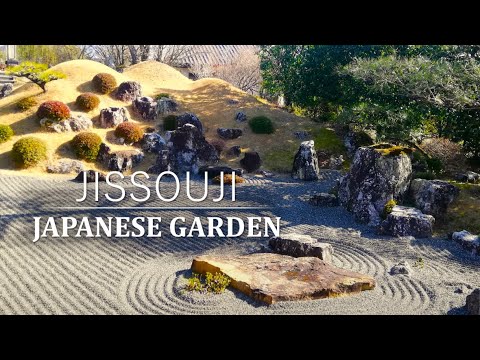JISSOUJI:
1371 Kanazashi, Hikisa-cho, Kita-ku, Hamamatsu City, Shizuoka Prefecture, JAPAN
Filmed on 2023/03
Playlist : Japanese Gardens
website :
https://jgc28.my.canva.site/
#japenesegarden
#gardentour
#drygarden
#gardens
Jissoji Temple, located in Hamamatsu City, Shizuoka Prefecture, was founded in 1387 and has a dry garden believed to have been created in the early Edo period (1603 – 1868). View from the east corridor of the main hall
We will look at each of the stone arrangements set up in this garden and their meanings later. In 1994, the garden was restored and made famous after the discovery of its masonry by the Nakane Garden Research & Landscape Consultant Co. of the gardener, Kinsaku Nakane.
Nakane is a gardener who has created many gardens both in Japan and abroad, and is especially famous for the garden of Adachi Museum of Art, which has been ranked number one in the Japanese garden ranking of an American Japanese garden magazine for over 20 years.
The stone that borders the corridor of the main hall is one of a pair of “Niou” stones in the garden. “Niou” stones, also called Nishin stones are usually composed of two or three stones of different sizes, each representing deities, Buddha, etc.
Jissoouji garden is only as far as can be seen from this corridor, and it takes less than a minute to simply look at it. However, each of the stone arrangements in the garden that can be seen from here represent various things.
Are there any stone arrangements that you can understand the meaning of without explanation? Personally, I recognized three masonry arrangements at a glance, but there were many other arrangements that were not recognizable without explanations, so let’s take a look at them as we identify them.
View from the south side of the garden The stone in the foreground looks like a boating stone because of its shape. Boat stone is based on the belief of the Immortal God,
And refers to the stone that represents a boat coming and going to Horai Island to obtain the elixir of life. The reason why the stone in the front is considered to be a boat stone is not only because of its shape,
But also because there is a stone in the back that represents Horai Island. Now, let’s check the stone arrangement including the stone that represents Horai Island. The large, flat stone placed in the center of the dry garden is a “reihai” stone for worship.
Usually, it is placed at the edge of the pond, but here it is placed in the center of the gravel that imitates the surface of the water. The stone placed beside a reihai stone is called “Tegake” stone or “Shokou”stone.
Another Niou stone, paired with the one identified a short while ago. The masonry in the middle of the hillside represents a waterfall as a whole, while each stone has its own meaning The boat represented by the boat stone is headed for this Horai Island.
It is an island where immortal immortals live, and it is assumed that there is a medicine for immortality. Diagonally above it is a stone representing the Ryumon Falls. Diagonally below it, there is a stone called “Rigyo” stone, which represents a carp climbing up the waterfall.
If you look further up, you will see the triad stones. Normally, the worship stone in the center is placed in the direction of worshipping the triad stones Finally, we can see the top of the mountain.
The image becomes grainy due to enlarging, but what you can see between the peaks is the Enzan stone. This represents a mountain in the distance If you look at the garden after confirming the meaning of each stone, you will see the entire garden as a cohesive landscape
A waterfall flowing from an artificial hill to the sea and Horai island floating in the tournament. The water flows from the north side to the south side, and the boating stone goes to Horai Island as if going up the stream.
The masonry on the east side of this garden also has another meaning, so let’s check it out. A large stone was set up as a crane wing stone, and this stone was surrounded by a crane stone group. The turtle stone set can be seen in the back.
The crane and turtle masonry is seen from another angle. Since cranes and turtles are both long-lived animals, their figures have been imitated in many Japanese gardens using stones and trees as a symbol of longevity since ancient times
Shizuoka Prefecture, where Jisso-ji Temple is located, is the birthplace of Kinsaku Nakane, a well-known garden designer who is also associated with this garden. To access Jissouji Temple from Tokyo or Osaka takes about three hours in any case. It takes longer than traveling between Tokyo and Osaka
Because you need to change to a conventional train on the way. However, in the area around Jissouji, you can see a different Japanese landscape from that of the big cities. If you like this video, please subscribe and give it a thumbs up👍. Thank you for watching!

